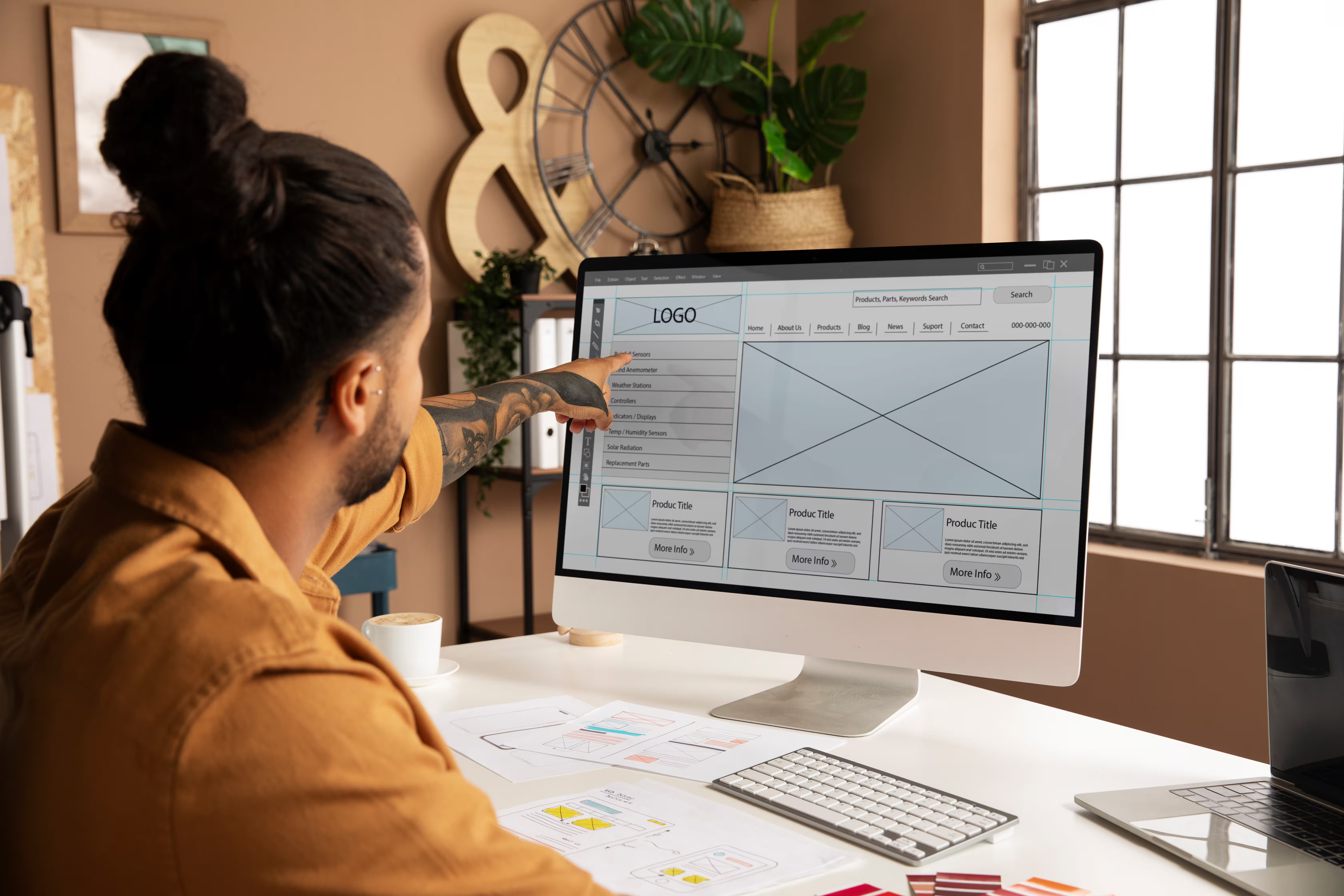Coming to this blog you are probably wondering what’s the difference between these two tools. The consensus is that Webflow is best for building websites and Bubble for web apps. But what does it mean and how do you know which tool to choose? Let’s dive into the breakdown of both tools!


Webflow vs. Bubble: What’s the difference?
Webflow is a no-code tool that gives you the power to build responsive websites without writing a single line of code. Designers get the power of CSS, HTML, and JavaScript in an easy-to-use visual canvas. With underlying code still accessible, Webflow allows complete design freedom. Webflow goes even further and can handle hosting, security, and website performance itself. It is also more than a website building tool, it's also a CMS.

Bubble claims that it is the most powerful no-code platform for creating digital products without code. Like Webflow, it gives you the full powers of CSS and HTML without writing a single line of code. It handles deployment and hosting for you, so you don't have to worry about this as well. Bubble helps you to create interactive and multi-user Web apps and serves as a perfect tool for building your first MVP or a prototype.

As you can see, both tools are no-code web app development platforms that are more or less the same at first look. Let's get a bit more into the details to find the key differentiators.
Comparison list
We understand that you are busy, and you might not have the time to go through the whole article. The good news is that you don't have to! We created this comparison table to help you grasp the key differentiators.
Webflow vs. Bubble: Pricing
No matters the difference and the features, the final decision point is always the price. So let's start the head-to-head comparison by reviewing the pricing tiers.
Webflow offers 12 different pricing tiers that are divided into three main categories.
- Site plans are best for simple or content-driven websites.
- Ecommerce plans are best for e-commerce stores.
- Workspace plans allow you to manage multiple sites and collaborate with a larger team.

The great thing about Webflow is, that you can build your whole site for free before deciding to go live. You can tweak your site as long as you want before launching, and take your time in making it perfect.
When you are ready, you can pick a site plan that starts at $12/mo and go up to $36/mo for business. Ecommerce plans start at $29/mo and go up to $212/mo when billed yearly for an advanced plan.
When you work in a team, you can pick the Workspace plan. The core plan enables you to invite 3 team members and will cost you $19/mo per seat. The growth plan will unlock up to 9 seats and will cost you $49/mo per seat.
All enterprise plans in every category are completely customizable, and vary case by case. For more pricing details, check out Webflow's pricing page.
Bubble offers 4 different pricing combinations with the option to buy more storage at intervals. It also offers a free plan that allows you to learn the platform and build your application. You will have to move to a paid plan when you want to add some extra features, such as white labeling, a custom domain, access to the Bubble API, etc.

Bubble's pricing is not determined solely on the features, but also capacity. Capacity determines how large your app is and how many users are interacting with it.
You can choose among 3 different paid plans when using Bubble.
- Personal plan
- Professional plan
- Production plan
A personal plan will cost you $25/mo when paid annually. It equips you with the core platform + API, custom domain, Email support, etc.
The professional plan will cost you $115/mo when paid annually. It includes 3 units of server capacity, 2 app-editors, 2 development versions, etc.
The production plan will cost you $475/mo when paid annually. It includes 10 units of server capacity, 15 app-editors, 20 development versions, etc.
Webflow vs. Bubble: Head-to-head comparison
Design freedom
When it comes to designing beautiful and pixel-perfect sites, Webflow is the winner. It allows designers to get the full power of CSS, Js, and HTML without ever touching the code. Every new page you build starts as a blank canvas that you edit with the visual editor. Webflow works hard under the hood and translates your designs into clean and semantic code.
Webflow also offers a rich library of free and premium templates you can use for various use cases. All sites you create are responsive and instantly ready to be displayed on every screen size. You can check the collection of the best available free Webflow templates following this link here.

When it comes to Bubble, you start with white canvas as well. There you can right away add elements like text, images, buttons, etc. with drag and drop functionality.
But you don't have to start from scratch, you can choose among 903 templates made by the Bubble community. The only drawback here is, that using a template for an MVP or Web app doesn't always work well. When you build a Web app, you will build it with great functionality in mind. And available templates are not usually not tailored to the exact functionality of your app.

Finding the right and useful template can therefore be a struggle when building a complex app. Just keep in mind that this setback is still easier than coding everything from scratch.
Key features
The key difference between the two tools is, that Webflow enables you to create robust animations and responsive websites. With easy-to-use CMS-based database functionality, Webfllow is heavily geared toward building:
- Responsive and high-performing websites
- Ecommerce stores
- Landing pages
- Blogs

Bubble enables you to create superior workflow functionality. It chains together actions to produce app-like behaviors. It also has built-in user management that Webflow does not.
This makes Bubble a tool, that is mostly used for building prototypes, web apps, and MVPs.
The learning curve
When it comes to comparing the learning curve of both platforms is easy to say that mastering Bubble is much more difficult. But this is not exactly a fair comparison...
When we talk about mastering Bubble, we mean everything from designing a web portal to launching your web app. But, when we compare only the web page building difficulty, it easily compares to Webflow.
If you have the fundamental knowledge of web design and code, Webflow is fairly easy to use. It gets a bit more complex when you want to create more than static pages. For creating interactive and complex interactions, strong knowledge of CSS and Javascript is a must.
Webflow also offers an amazing array of resources in their Webflow university. There you can find actionable tips and lessons, and even fully certified courses. And the best thing about it? All lessons are completely free!

Like we already said, when we talk about a Bubble learning curve, we mean everything from designing a web portal to launching your web app. When taking all this into account, the learning curve is quite steeper than with Webflow. If you want to create a Web App, you have to understand the platform for integrating backend and database systems.
Time learning Bubble will thus vastly depends on what kind of product you wanna build. Building a single one-page web app will be a walk in the park. Creating an in-depth, and complex app with countless workflows will be a different story.
Bubble offers a big selection of crash courses on Bubble academy. The academy even offers a series of 20 videos that teaches you how to create your first Bubble app. Bubble also has quite a community of people that can help you solve problems and minor issues when you are still learning the tool.

Webflow vs. Bubble: Compare projects
To help you understand the difference between those two tools, even more, we created a list of projects done with either Webflow or Bubble.
Here is a list of 5 projects done with Webflow:
Here is a list of 5 projects done with Bubble:
Conclusion
As we have seen in this articles, both Webflow and Bubble are powerful no-code tools with a wide array of features. However, they take a different approach to building projects. Webflow is better at handling content and creating high-performing websites. Bubble is superior in creating fully functional and complex Web apps.
Webflow has been on the market for quite some time now and has been established as a leading no-code tool for designing websites. It also offers a rich template library and numerous integrations to help enhance your site functionality. Without ever writing a line of code, Webflow allows you to create a beautiful and responsive website.
As Webflow is focused on front-end even triggers, Bubble takes all the focus to the back-end. This means Bubble allows you to create complex and functional applications that can serve as an amazing prototype or MVP. The tool comes with a complete database and lets you use conditional situations, including how your visitors respond to certain content.
Frequently asked questions
What is the difference between Webflow and Bubble?
Webflow is a no-code tool website builder that allows you to create responsive and animated sites. Bubble is a no-code tool that allows you to chain together actions and produce app-like behaviours.
Is Bubble free to use?
Bubble’s free plan enables you to learn the platform and build a robust application. When you want to add extra features to give your app more functionality you will have to pick out one of the priced plans.
Is there a Webflow app for mobile?
Unfortunately, no. Webflow does not have its own mobile app available to download from the App Store or Google play.




















